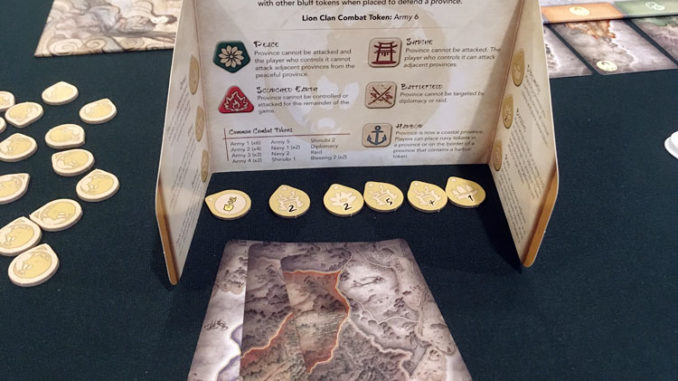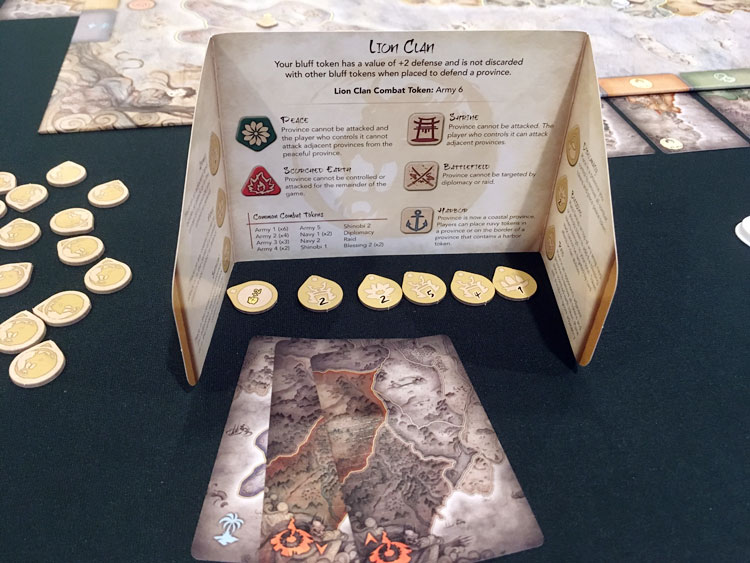
I am a sucker for strategy games. As a kid I had a Risk computer game that I played until the disc stopped working. And Risk is all well and good if you like a classic (and don’t mind playing for six hours), but have you heard of Battle for Rokugan?

This 2-5 player game of conquest, deception, and strategy is easily one of my favorite games of all time. You can play it in 45 minutes to an hour and a half, but it will feel like a much shorter time has passed. It takes up quite a bit of space, but everything is very stable, so it’s easy to place on the floor if you have a larger group. Setup is very intuitive, as each territory card has a nice defined slot, each player has an allocated shield, and everything is delightfully color-coordinated.
Players choose from one of seven samurai daimyos, each of which comes with special perks and abilities. They must conquer provinces and larger territories to gain honor, the victory points that determine the winner of the game. Each player also has a secret objective they must complete that will give them extra honor. If a player controls a complete territory (usually made up of three provinces) at the upkeep phase, they draw special reward cards that correspond to that territory, gaining perks and actions that help them on their quest.
Combat takes place between tokens: blessing, Diplomacy, army, navy, raid, and shinobi. All tokens are placed face-down in a draw pile, and players draw up to six tokens each turn. This adds an element of strategy because you only get certain tokens (say, an army 5) once per game, and have to use them wisely. Each token has unique abilities and each player has a unique token, so different factions really do play and function very differently.
Battles between clans can take place on borders of land via armies or sea via navies—or if you draw a Shinobi token, you can send your stealthy troops directly to the heart of the territory and strike from within. Blessing tokens add buffs to an attack or defense equal to the number on the token. Diplomacy tokens make a province peaceful, making it impossible to attack (or attack from) that province. Raids do a similar thing but via opposite means, burning a province to the ground and making it impossible to conquer.
Players also possess a bluff token, a token that essentially functions as a blank. They can use this token to fake other players out and force them to use up valuable resources, or pretend to defend a territory you don’t actually need in order to strike at them from a different direction. Players are given three single-use cards at the start of the game: two scout cards and a shugenja card. Scout cards can be used to peek at a token an opponent has placed on the board, which can save a player from being tricked by the bluff. The shugenja card allows you to peek and discard a token, opening the possibility of staving off a raid, wrecking a defense, or holding a territory when it matters most.
Players win by having the most honor at the end of the game. This can be achieved by holding territories, successfully defending those territories, adding honor tokens through territory cards, and achieving secret objectives. Often the tide of power shifts dramatically turn-to-turn, and a single strike at the end of the game can cost a player everything they worked for the previous four rounds.
My Ratings
Mechanics: 5/5
The rules are not only intuitive to pick up, they also make sense within the world of the game. There are elements of luck, strategy, and personal play style that make Battle for Rokugan an absolute delight. The game is intensely thematic and really creates a strategic wonderland for lovers of Japanese mythology and culture.
Gameplay: 5/5
I’ve played this game with 2, 3, and 5 people. The more people who play, the harder it is to achieve objectives, but the easier it is to sneak around and work on your own goals without anyone paying attention to your actions. I’d say 3-4 is just about right. Depending on number of players and which factions you play with the game is different every time, and it has enormous replay value in my opinion.
Components: 5/5
This is an insanely beautiful game. The artwork of the board is reminiscent of traditional Japanese painting, elegant and slightly abstract. The cards and tokens are sturdy and easy to tell apart, and there are enough alternate territory cards that you can play five or six times before you’ve seen them all. A lot of care went into making each piece of this game, and it’s obvious in the quality of the components.
Overall: 5/5
This intense game of shifting borders and deception is an instant success in my book. Because it’s so quick to play and easy to learn, it’s one of the best games to whip out at a group gathering. If you haven’t played it, I highly recommend it!



Be the first to comment